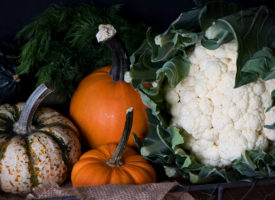Ah, autumn. Cool crisp weather, vibrant changing leaves…and loads of candy, desserts, fat-filled dishes, calorie-laden snacks, and all sorts of dietary pitfalls that kick off the holiday season. But finding healthy fall foods isn’t as difficult as you may think.
Colorful and Healthy Fall Foods
Rather than indulging in all those empty calories in the coming months, make these nutrient-rich, vitamin-packed, seasonal vegetables mainstays in your diet. Your health—and your waistline—will benefit.
1. Broccoli. Broccoli is one of those often-overlooked healthy fall foods. It’s a nutritional powerhouse that protects against cancer of the colon, breast, bladder, lung, and prostate. Along with cauliflower and other cruciferous vegetables, broccoli contains sulforaphane glucosinolates (SGS) and other phytonutrients that shield cells from DNA damage, boost immune function, and neutralize carcinogens.
In a study published in the Journal of the National Cancer Institute, older men who ate broccoli or cauliflower more than once a week were about half as likely to be diagnosed with aggressive prostate cancer as men who ate these foods less than once a month. The richest source of protective phytonutrients is young broccoli sprouts; however, all broccoli offers protective benefits.
2. Brussels Sprouts. Many people shy away from Brussels sprouts but these healthy fall foods are packed full of health benefits and should grace your table on a regular basis. In the same family as broccoli and cauliflower, Brussels sprouts have anti-carcinogenic properties—and they are rich in calcium. They also boast a decent amount of protein and contain lots of fill-you-up fiber and free-radical-scavenging antioxidants.
Believe it or not, Brussels sprouts can actually be quite delicious when prepared properly. Try lightly coating them with a little extra-virgin olive oil, seasoning with salt (or salt substitute) and a little pepper, and roasting in a 400-degree oven for approximately 40 minutes. (Shake the pan every now and again so they brown evenly.) Another option is to steam your sprouts and then toss them in a mixture of olive oil, lemon juice, minced garlic, and pepper.
3. Sweet Potatoes. Sweet potatoes dripping with sugary syrups and marshmallows are often a Thanksgiving staple. But these healthy tubers are loaded with the carotenoid beta-carotene as well as potassium and calcium which is why they are included in our top five healthy fall foods list. They can be good for you, provided you lay off the unhealthy toppings.
Try serving baked sweet potatoes in place of regular potatoes with a little Greek yogurt and nutmeg as a topping. Or roast them with a sprinkle of cinnamon and a little butter (organic preferred). Sweet potatoes also make a wonderful addition to soups and stews.
4. Cauliflower. Like broccoli, cauliflower is a cruciferous vegetable packed with phytonutrients and known for its protective effects against cancer. It’s high in immune-boosting vitamin C and very low in calories. Cauliflower contains very little fat and is also a good source of fiber.
Watching your weight? An entire cup (100 g) of raw cauliflower only contains about 25 calories, so feel free to snack away. Raw, steamed, or mashed, you can’t go wrong with this vegetable powerhouse. Learn how to make a delicious cauliflower mash here.
5. Pumpkin. No list of healthy fall foods would be complete without pumpkin. The “meat” of the pumpkin is chock-full of fiber, beta-carotene, and other carotenoids. But the real superstar is the seeds. Pumpkin seeds contain phytonutrients called cucurbitacins, which help slow the growth of the prostate. They do so by inhibiting the transformation of testosterone into dihydrotestosterone, the hormone that fuels benign prostatic hyperplasia (BPH), or age-related enlargement of the prostate. In addition, pumpkin seeds contain high levels of zinc, which not only protects the prostate but also promotes bone, eye, and immune health. Finally, they are loaded with omega-6 essential fatty acids, manganese, and other nutrients.
I recommend eating a small handful of pumpkin seeds daily. Learn how to roast your own here. You can also find pre-roasted seeds in your local grocery or health food store.
Healthy Fall Foods Recap
So, there you have it. Five fresh, seasonal, healthy fall foods that should regularly grace your plate in the coming months. If you have recipes that incorporate these nutritional powerhouses, please send them to [email protected].


